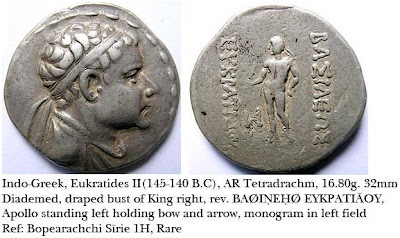After death of Alexander in 323 BC, his generals, known as diadochi started fighting for his massive empire. Seleukos Nictator, a friend and general of Alexander proclaimed himself King of Persia,Bactria (afghanistan) and Syria. He founded a dynasty named after him, widely known as Seleukid dynasty. He had his capital at Babylon and invaded India (modern Punjab, located in northern India and Pakistan) in 304 BC, which was then Muaryan empire ruled by Chandragupta Maurya.
The portraits on all Indo-greeks coins are very realistic which express powerful features and minute personal details very clearly. This indicate that all the engravers were from same school of art and obviously very well familiar with Hellinstic art. Indian coinage is greatly enfluenced by coinage of Indo-Greeks. The policy of rulers to show their subject their true appearance was totally unknown in Indian subcontinent. The first Indian King who issued coins bearing his portrait was Saubhuti (Sophytes or Sopeithes according to Greek historians). He ruled in Bactria or Panjab in 315-305 BC and minted Greek styled coins . His silver coins were greatly enfluenced by his contemporary Bactrian Greek ruler Seleucus Nictator. He is the first Indian ruler whose name and portrait appears on a coin. The reverse shows cock standing right.
In 281 BC Seleukos was assasinated but the kings who followed him maintained friendly relationship with mighty Mauryan emperors for some time . Seleucid empire disintegrated soon after assasination of Seleukos into Parthia (Arsaces as King), Syria (Antiochus I as king) and Bactria (Diodotus as king).











No comments:
Post a Comment